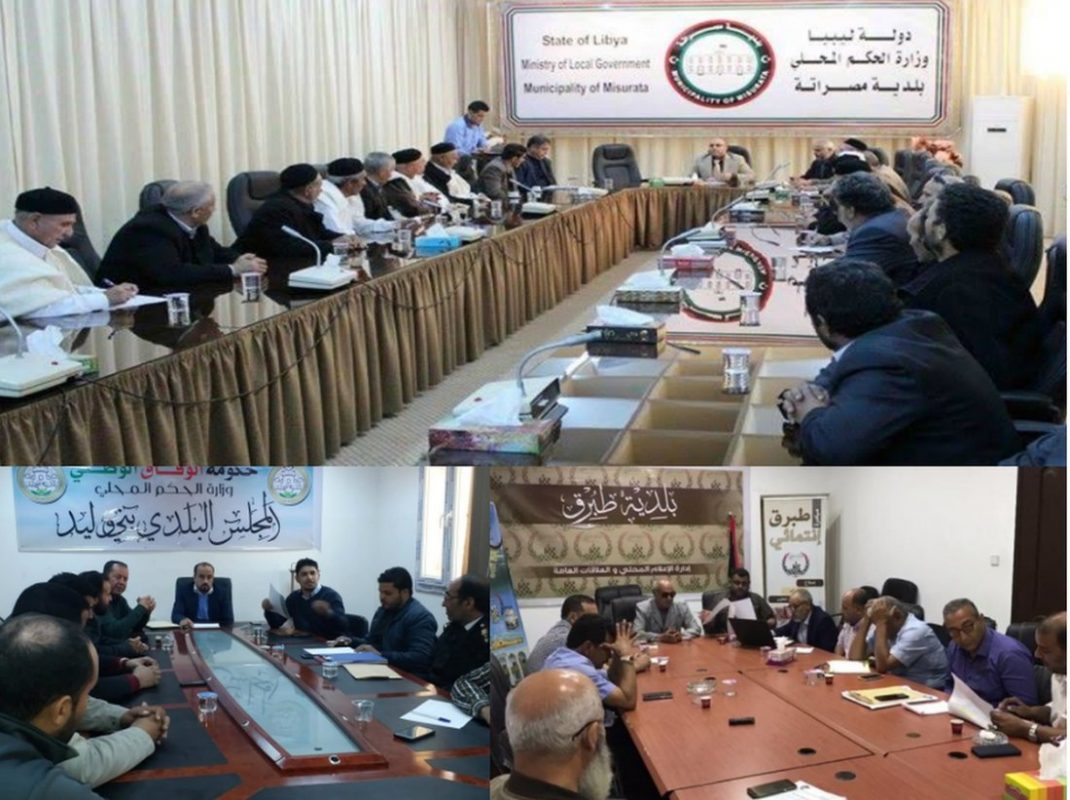By Wolfram Lacher
 In post-revolutionary Libya, the collapse of central authority and the fragmentation of territorial control have produced a fundamental change in the political elite.
In post-revolutionary Libya, the collapse of central authority and the fragmentation of territorial control have produced a fundamental change in the political elite.
.PART SIX
Conclusions: Explaining choices and shifts in local elites’ strategies
After the fall of the Qadhafi regime, Libya’s local elites gradually coalesced into two rival camps, provoking escalating violent conflicts.
As of December 2014, competing claims to legitimacy had forestalled the establishment of a broadly accepted political order.
The return to a single government will depend on whether local interests can realign themselves from two polarized camps to a loose and heterogeneous coalition at the centre.
The trajectories of local elite strategies in the three cities varied. Misrata built a national coalition of revolutionary forces with the ambition of seizing central authority.
Faced with a backlash from rival local power centres and the rifts this provoked in Misrata itself, the city’s hardliners opted for all-out confrontation, closing ranks at home but dividing the country before splitting again when the time came for negotiations.
Bani Walid’s attempt at building a counter-revolutionary coalition of groups excluded from the new order had dire consequences for the town and provoked internal divisions that made it irrelevant to the national political game.
Meanwhile, Tobruk remained at the margins, in part by choice. However, after a brazen attempt by local actors to seize state assets failed, Tobruk’s elite joined a broad coalition with ambiguous goals, eventually finding itself at the core of this alliance more by accident than by design.
The central government hardly featured as a player in these struggles, for the primary reason that it was completely at the mercy of diverse local interests with a stake in it.
The government’s weakness and its function as a bounty for local interest groups also explained why local councils were not the central loci of decision making in the three cities.
Informal networks and ways of exerting pressure were much more effective in mobilizing state resources, and little local legitimacy could be gained by acting as the official link between the local level and an embattled government.
Structural factors and historical contingencies were important in shaping elite strategies.
Misrata was able to emerge as a leading player because of the resources commanded by its business elite, which directly translated into military power.
Bani Walid’s elite was reduced to the symbolic capital of tribalism and tribal alliances once its long-standing source of influence – its role in the security apparatus and the administration – had dried up.
Tobruk’s failure to emerge as a player on the national stage stemmed in part from its peripheral location and from the local elite’s focus on a trans-border economy that was by definition outside state control.
Seizing the local oil infrastructure and opposing the revolutionary camp taking power in Tripoli made sense from Tobruk’s marginal perspective.
Structural factors and historical contingencies also shaped these local elites’ attempts to pool resources.
Misratan hardliners allied themselves with local revolutionary strongholds and national Islamist forces, thereby building a substantial bloc in the GNC and the country’s dominant military alliance.
For Misrata’s elite, this was useful not only because of the greater influence that came with the alliance, but also because it served to dilute the widespread perception of Misratan supremacy in national politics, a perception that increasingly became a liability.
Bani Walid’s counter-revolutionary elite largely focused on pooling symbolic capital, by uniting tribal constituencies excluded from the new order that were unable to challenge the revolutionary forces militarily or in formal institutions.
Parts of Tobruk’s elite built a regional alliance that combined tribal prestige, business interests and the military power of its allies in the oil crescent.
After this failed, Tobruk joined a broad coalition in which federalists connected with the political networks of the NFA and the military power of Haftar and Zintan.
Political, military and financial resources created a formidable tactical alliance. These structural factors, however, only partly explain strategic choices, as shifts in strategies by all three local groups suggest.
Using the typology of strategic choices open to local elites outlined above, Misrata’s elite set out with a strategy of the first type (dominant alliance), but shifted to a strategy of the second type (veto power) when the balance of forces in government institutions changed.
Bani Walid’s counter-revolutionary elite initially opted for a strategy of the second type (veto power), but was shattered by the backlash this triggered and thereafter vanished as a strategic player in the national arena.
Bani Walid’s revolutionaries sought to join a dominant alliance to expand their local influence, but given the central government’s weakness, they had limited success with this strategy.
After a period of remaining focused on the local level, parts of Tobruk’s elite experimented with a strategy of the second type, pushing for autonomy, but joined a potentially dominant coalition when this strategy failed and proved locally divisive.
These shifts were partly reactions to the moves of other groups, rival and allied, but they were also driven by local reactions to the strategies adopted by dominant local players.
A credible claim to speak for their communities was local elites’ most valuable symbolic resource.
Local elites’ strategies at the national level in part aimed at strengthening their credibility as representatives of their communities and shaping local opinion.
In all three cities, local elites mobilized demonstrations to show that their positions enjoyed broad support while also discouraging or repressing alternative views.
Elites in Misrata and Bani Walid pursued confrontational strategies at the national level to cement their position at the local level, thus forcing local actors to choose between supporting their town’s leaders or being stigmatized as traitors.
In Bani Walid, this strategy backfired because of the town’s military weakness. In contrast, Misrata’s hardliners pursued this strategy ever more radically after the first signs of local opposition became apparent.
In late 2013 and early 2014, Misrata’s national role caused local quarrels, weakening the ability of leading figures to speak for the city.
When its leaders called for the defence of the revolution, however, local interests closed ranks, at least in public. In Tobruk, one elite faction’s attempt to extort the central government also provoked local divisions.
Local unity in backing an alliance of conservative elites from May 2014 onwards could be attributed to the ambiguous goals of that alliance, which claimed control over national institutions but also served the interests of the autonomy movement.
The hypothesis emerging from these observations is that alliance building by Libya’s local elites inevitably provoked local divisions.
This was not simply because of the impact on local politics of the increased influence that came with local actors’ participation in larger alliances.
It was also due to the necessity that such alliances be based on a supra-local political project – such as regional autonomy, revolutionary purges or an Islamic state – that would necessarily provoke local dissent.
Forming larger political alliances put local unity at risk, threatening the credibility of local elites as representatives of their constituencies – their key symbolic resource – and, ultimately, their control over local territory.
In other words, building alliances at the national level posed a strategic dilemma for Libya’s local elites.
This dilemma helps explain why, three years after the demise of the Qadhafi regime, cohesive national political forces had yet to emerge.
***
Wolfram Lacher is a researcher at the German Institute for International and Security Affairs in Berlin. His research focuses on Libya and security issues in the Sahel and Sahara region.
__________
Stiftung Wissenschaft und Politik, Berlin, Germany





